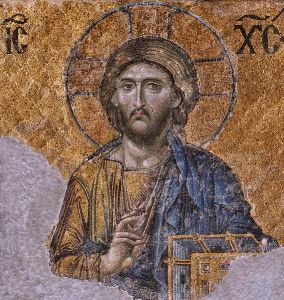
°°°
In verse 26 of Chapter Four of The Gospel of John (τὸ κατὰ Ἰωάννην εὐαγγέλιον) Jesus, speaking to a Samarian woman, is recorded as saying: Ἐγώ εἰμ ιὁ λαλῶν σοι. The first part – Ἐγώ εἰμ – literally means “I am.” Most translations insert ‘he’ – “I am he” – which in my view seems to somewhat lesson the impact of what Jesus says, which is that he just “is”, beyond causality itself and thus beyond any manifestation of Being – on Earth – as “a being”, be such a ‘being’ the mortal Messias or some other mortal. Expressed less philosophically, Jesus says that it is the divinity who is speaking to her: “it is I AM who is speaking to you,” which expression is what I, during my short perambulation as a Catholic monk wrote, near the verse in the margin of my copy of τὸ κατὰ Ἰωάννην εὐαγγέλιον.
Revisiting such marginalia decades later during my translation of and commentary on eight tractates of the Corpus Hermeticum, I began to translate the Gospel itself and which translation and the accompanying commentary given the relevance of the Gospel to particular verses in some of those tractates, for example φῶς καὶ ζωή ἐστιν ὁ θεὸς καὶ πατήρ, ἐξ οὗ ἐγένετο ὁ Ἄνθρωπος (phaos and Life are the theos and the father from whence the human came into being) from the Pœmandres tractate and ἐν αὐτῷ ζωὴ ἦν, καὶ ἡ ζωὴ ἦν τὸ φῶς τῶν ἀνθρώπων καὶ τὸ φῶς ἐν τῇ σκοτίᾳ φαίνει καὶ ἡ σκοτία αὐτὸ οὐ κατέλαβεν (Who was Life and which Life was the Phaos of human beings. And the Phaos illuminates the dark and is not overwhelmed by the dark) from Chapter One of John.
This led to further questions some of which I discuss here.
The Johannine Weltanschauung
°°°
Image credit:
Icon of Jesus Pantocrator, Δέησις Mosaic
Hagia Sophia, c. 1260 CE
The Johannine Weltanschauung
0
°°°
In verse 26 of Chapter Four of The Gospel of John (τὸ κατὰ Ἰωάννην εὐαγγέλιον) Jesus, speaking to a Samarian woman, is recorded as saying: Ἐγώ εἰμ ιὁ λαλῶν σοι. The first part – Ἐγώ εἰμ – literally means “I am.” Most translations insert ‘he’ – “I am he” – which in my view seems to somewhat lesson the impact of what Jesus says, which is that he just “is”, beyond causality itself and thus beyond any manifestation of Being – on Earth – as “a being”, be such a ‘being’ the mortal Messias or some other mortal. Expressed less philosophically, Jesus says that it is the divinity who is speaking to her: “it is I AM who is speaking to you,” which expression is what I, during my short perambulation as a Catholic monk wrote, near the verse in the margin of my copy of τὸ κατὰ Ἰωάννην εὐαγγέλιον.
Revisiting such marginalia decades later during my translation of and commentary on eight tractates of the Corpus Hermeticum, I began to translate the Gospel itself and which translation and the accompanying commentary given the relevance of the Gospel to particular verses in some of those tractates, for example φῶς καὶ ζωή ἐστιν ὁ θεὸς καὶ πατήρ, ἐξ οὗ ἐγένετο ὁ Ἄνθρωπος (phaos and Life are the theos and the father from whence the human came into being) from the Pœmandres tractate and ἐν αὐτῷ ζωὴ ἦν, καὶ ἡ ζωὴ ἦν τὸ φῶς τῶν ἀνθρώπων καὶ τὸ φῶς ἐν τῇ σκοτίᾳ φαίνει καὶ ἡ σκοτία αὐτὸ οὐ κατέλαβεν (Who was Life and which Life was the Phaos of human beings. And the Phaos illuminates the dark and is not overwhelmed by the dark) from Chapter One of John.
This led to further questions some of which I discuss here.
The Johannine Weltanschauung
°°°
Image credit:
Icon of Jesus Pantocrator, Δέησις Mosaic
Hagia Sophia, c. 1260 CE
Share this:
Related
Filed in Christianity, David Myatt, DW Myatt, τὸ κατὰ Ἰωάννην εὐαγγέλιον, Jesus Of Nazareth, New Testament, Novum Testamentum Graece, Personal Comments, Way of Pathei-Mathos
Tags: Catholic Church, Christianity, David Myatt, Evangel of Jesus of Nazareth, Gospel of John, τὸ κατὰ Ἰωάννην εὐαγγέλιον, Novum Testamentum Graece, Numinous Religion, Way of Pathei-Mathos